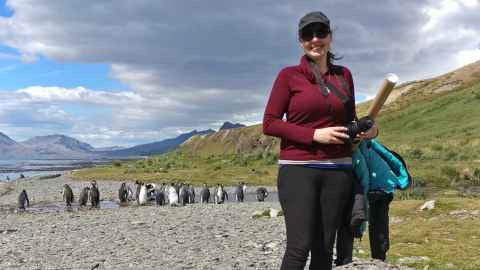Take 10 with... Emma Carroll
Dr Emma Carroll from the School of Biological Sciences gives us 10 minutes of her time to discuss how molecular methods can provide amazing insights into the lives of otherwise hard to study animals such as the southern right whale.

1. Describe your research topic to us in 10 words or less.
Genomic tools and mathematical models help me understand marine mammals.
2. Now explain it in everyday terms!
Molecular methods can provide amazing insights into the lives of otherwise hard to study animals. For example, a small skin sample collected from a living whale can generate a DNA profile that provides an individual ID for each animal and tells us who their family is.
It can produce a micro-chemical signature that provides information on where and what the whales have been eating.
As part of my Rutherford Discovery Fellowship, we will develop a new DNA based method to provide a reliable, non-lethal way to estimate the age of southern right whales, from just such a skin sample.
Statistical models allow me to combine these different data types to test hypotheses on the structure and connectedness of natural populations, and to estimate key population parameters like abundance and growth rate.
3. Describe some of your day-to-day research activities.
Most of the time I am either in the lab working on preparing DNA for genomic sequencing or at the computer analysing the genomic data, but this year I am going to spend a few months doing field work around South Georgia in the sub-Antarctic South Atlantic.
4. What do you enjoy most about your research?
I enjoy solving a puzzle, using different methods and working with different people.
5. Tell us something that has surprised you in the course of your research.
The way that animals behave – it’s often surprising, and we need to do a better job of incorporating it into how we study them.
6. How have you approached any challenges you’ve faced in your research?
Working on long-lived species such as whales means it can be hard to understand whether a population is increasing or decreasing without decades-long datasets. In a rapidly changing world, we need better tools to understand what populations need direct conservation action now.
7. What questions have emerged as a result?
How do we get good data on population trends, in a timeframe that means management action can be taken in time to make a difference? I am working with the pioneers of new statistical methods that can address this challenge in a New Zealand model system, southern right whales, and hope that the work will have broad application.
8. What kind of impact do you hope your research will have?
Much of my work is on endangered species, so the findings are often used in conservation and management.
9. If you collaborate across the faculty or University, who do you work with and how does it benefit your research?
I believe that the best science is collaborative and engaging. Within the School of Biological Sciences, I work with Associate Professor Rochelle Constantine and I also work with Associate Professor Rachel Fewster from Statistics. Not only are they great mentors but we bring diverse perspectives and skillsets to projects.
10. What one piece of advice would you give your younger, less experienced research self?
Be more confident, and annotate your code properly!